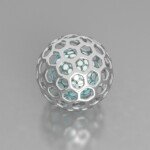Unleash your creativity: Pro tips for 5-axis CNC woodworking
Five-axis CNC woodworking has revolutionized design and manufacturing, allowing intricate details, complex geometries and unprecedented precision in wooden creations. Five-axis technology breaks through the limitations of traditional three-axis machining, moving the cutting tool along five different axes simultaneously, providing unparalleled workpiece processing capabilities and the ability to create parts with undercuts, engraved surfaces and complex curves without the need for multiple setups.
However, unlocking the full potential of five-axis CNC woodworking requires more than advanced machinery; it requires a deep understanding of the processes, materials and software involved. This article delves into professional tips that can elevate your five-axis woodworking project from mere execution to work of art.
1. Master CAD/CAM of complex designs:
The foundation of any successful five-axis project lies in CAD/CAM software. Choose a software package designed specifically for five-axis machining and take the time to master its intricacies. Key aspects include:
- Tool path generation: Focus on creating efficient and collision-free tool paths. Try different strategies such as side cutting, contour milling and point milling to optimize surface finish, material removal rate and tool life. Many CAM software offer simulation/optimization to avoid errors.
- Simulation and verification: Rigorously simulate toolpaths before running them on the actual machine. This critical step allows you to identify and correct potential bumps, gouges, and other issues, saving time, material, and costly machine damage. Verify the program several times before sending it from the software to your computer.
- Post-processing: Make sure your CAM software is configured correctly for your specific machine and control system. The post-processor converts tool paths into machine-readable code (G-code), so accuracy is critical. Different machines require different postprocessors, so check the settings before running your program. Consider using multiple postprocessors
- Understand tool vectors: Understand the concept of tool vector, which defines the direction of the cutting tool. Proper manipulation of tool vectors is critical to achieving smooth surface finishes and accessing features from multiple angles.
2. Choose the right tool:
The right tools can greatly impact the efficiency, accuracy, and surface finish of a five-axis woodworking project.
- Special five-axis tools: Invest in tools specifically designed for five-axis machining. These tools often feature geometries optimized for multi-directional cutting and improved chip evacuation. Ball nose end mills are essential for engraving because of their ability to leave a smooth surface finish.
- Consider tool length and reach: Select a tool with sufficient length and reach to contact all features of the workpiece without collision. However, too long a tool length can cause vibration and reduced accuracy; aim for the shortest possible tool length while maintaining adequate working range.
- Material-specific considerations: Wood presents unique challenges for tools. Use sharp, high-quality carbide or diamond-coated tools to minimize tearing and splitting. Experiment with different groove geometries and coatings to find the best combination for your chosen wood species. Keep an eye on chip load (feed rate/RPM).
- Regular inspection and maintenance: Check tools regularly for wear. Replace worn tools promptly to maintain accuracy and prevent damage to workpieces.
3. Workpiece clamping strategies for complex geometries:
Safe and reliable workpiece clamping is critical to achieving precise and repeatable results in five-axis woodworking.
- Vacuum maintenance: Vacuum suction cups are ideal for holding large, flat workpieces. However, ensure adequate vacuum pressure and a good sealing surface to prevent slipping. May not always be suitable for all types of wood
- Mechanical clamping: Clamps, vises and fixtures can hold complex shapes more securely. Design custom fixtures to precisely position and support workpieces. Soft jaws and spacers help prevent damage to wood surfaces.
- Hybrid approach: Combining multiple workholding techniques can be very effective. For example, vacuum fixing is used to secure the workpiece while clamps are used to support specific features.
- Minimize vibration: Workholding should minimize vibration during machining. Support the workpiece as close as possible to the cutting area, using vibration-damping material if necessary. Add additional fixing and clamping components for extra support.
4. Material selection and grain orientation:
Understanding the properties and grain directions of different wood species is critical to achieving predictable results in five-axis woodworking.
- Wood Density and Hardness: Softer woods, such as pine, are easier to work with but may tear more easily. Harder woods like oak and maple provide better edge definition but require more powerful machines and sharper tools.
- Particle direction: Pay close attention to grain direction when designing and orienting parts. Reverse machining can result in chipping and poor surface finish. Position the part in such a way that most of the cuts are along the grain.
- Moisture content: The moisture content of wood affects its workability. Kiln-dried lumber is generally more stable and predictable than season-dried lumber. Allow the wood to acclimate to the shop environment before processing to minimize warping and cracking. Consider using wood found only in your area
- Wood type selection: Consider the end use of the product when selecting. If the project will be painted, consider wood with a minimal grain pattern.
5. Optimize cutting parameters:
Achieving the required surface finish, accuracy and tool life requires careful optimization of cutting parameters.
- Feed speed and spindle speed: Experiment with different feed rates and spindle speeds to find the best combination for your chosen wood species, tools and machine. Start with conservative settings and gradually increase settings until you achieve the desired results.
- Cutting depth: Use a smaller depth of cut for finishing to improve surface finish. Larger depth of cut can be used for roughing to remove material quickly.
- Coolant/lubricant: While not always necessary for woodworking, a small amount of coolant or lubricant can help reduce friction and heat, improving tool life and surface finish, especially when working with hardwoods. Dust removal is preferred, but coolant is also effective.
- Chip load: Monitor chip loads to ensure efficient material removal and prevent tool overload. Too little chip load can cause friction and premature tool wear, while too much chip load can cause chipping and breakage.
6. Dust removal is crucial:
Carpentry produces a lot of dust, which can be hazardous to your health and affect the accuracy of your machine. Invest in a high-quality dust collection system to remove dust from the cutting area.
- Local exhaust ventilation: Place the dust collection nozzle as close as possible to the cutting tool to capture dust at the source.
- Air filtration: Use a HEPA filter to remove fine dust particles from the air.
- Regular maintenance: Clean and maintain your dust collection system regularly to ensure optimal performance.
- Personal Protective Equipment (PPE): Wear a dust mask or respirator to prevent breathing harmful dust particles.
7. Continuous learning and experimentation:
Five-axis CNC woodworking is a growing field. Embrace continuous learning and experimentation to stay on the cutting edge of technology.
- Attend seminars and seminars: Attend seminars and seminars to learn new techniques and best practices from experienced professionals.
- online community: Join online forums and communities to connect with other five-axis woodworkers and share knowledge and experiences.
- Try new materials and techniques: Don’t be afraid to try new materials, tools, and techniques to push the boundaries of what’s possible.
By mastering these expert techniques, you can unleash the full potential of 5-axis CNC woodworking to create stunning, intricate, and precise wooden creations.
Gretel: Your precision CNC machining partner
As a professional five-axis CNC machining manufacturer, Honglaite provides advanced five-axis CNC machining equipment and production technology to solve your metal parts manufacturing needs. If you are looking for custom precision machining, GreatLight can provide a one-stop post-processing and finishing service using a variety of materials to provide fast and customized solutions. Contact GreatLight today to get the best prices on custom precision parts.
in conclusion
Five-axis CNC woodworking represents a major leap in manufacturing capabilities, allowing the creation of stunning, intricate designs. While the machines are complex, knowledge and application of the above techniques are essential to realizing your creative vision. By investing in quality tools, workholding, and software, along with a solid understanding of materials and cutting parameters, you can take your woodworking projects to the next level. Continuous learning and experimentation will ensure you stay at the forefront of this exciting technology. Remember, precision and innovation go hand in hand to achieve success.
FAQ
Q: What are the main advantages of 5-axis CNC over 3-axis CNC in woodworking?
A: The main advantage is the ability to machine complex geometries with undercuts, complex curves and faceted surfaces without the need for multiple setups. This significantly reduces processing time, increases accuracy, and enables more creative design possibilities.
Q: Does five-axis woodworking require special CAM software?
Answer: Yes, you need CAM software specifically designed for 5-axis machining. These programs provide the advanced toolpath strategies and simulation capabilities needed to avoid collisions and optimize cutting parameters for complex geometries.
Q: What type of wood is best suited for 5-axis CNC machining?
A: The best wood depends on project requirements. Hardwoods like maple and oak offer excellent edge definition, while softer woods like pine are easier to work with. Kiln-dried wood is often preferred because of its stability.
Q: How important is dust removal for five-axis woodworking?
Answer: Dust removal is very important. Wood chips are a health hazard and can also affect the accuracy of the processing process. A high-quality dust collection system is crucial.
Q: Can five-axis CNC woodworking use coolant?
A: While not always necessary, a small amount of coolant can help reduce friction and heat, improving tool life and surface finish, especially when machining hardwoods. It is also necessary to ensure that the coolant mist is discharged.
Q: How do I choose the right cutting tool for my 5-axis woodworking project?
A: Consider material type, geometry and desired surface finish. Use sharp, high-quality carbide or diamond-coated tools designed specifically for the task. Experiment with different groove geometries and coatings to find the best combination.
Q: What are the common problems with five-axis woodworking and how to avoid them?
A: Common problems include tears, chips, bumps and poor surface finish. To avoid these problems, use sharp tools, optimize cutting parameters, simulate tool paths, and properly secure the workpiece.
Q: Where can I learn more about 5-axis CNC woodworking?
A: Attend seminars and seminars, join online forums and communities, and consult with experienced mechanics. Continuous learning is key to mastering this technology.
Q: How much does a five-axis CNC machine cost?
A: Prices vary widely based on size, features, and manufacturer. They range in price from thousands to hundreds of thousands of dollars.
Q: Is five-axis CNC woodworking suitable for beginners?
A: Although challenging, beginners can learn 5-axis CNC woodworking with proper training and instruction. Start with simpler projects and gradually progress to more complex designs. The simpler 3-axis can also be a good starting point.










































